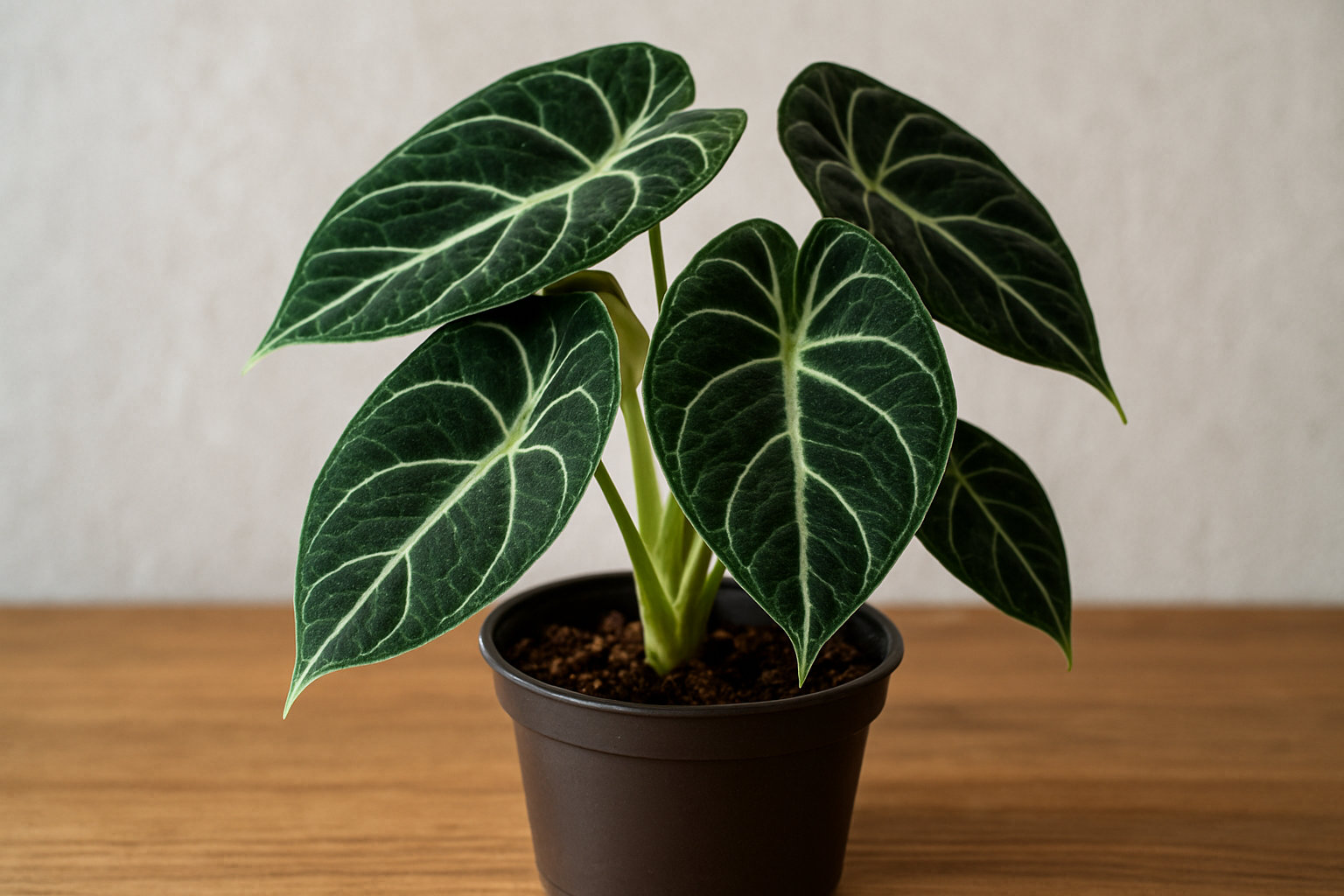The world of indoor plants is full of unique varieties that can instantly transform a living space, but few have the dramatic charm of Alocasia Black Velvet. With its rich, velvety foliage and compact size, this tropical beauty has become a favorite among plant lovers who want something striking yet manageable. Unlike many large alocasia species, this one stays small enough to fit perfectly into apartments, desks, and cozy corners while still offering an impressive, almost luxurious appearance.
In this guide, you will learn everything you need to know about Alocasia Black Velvet—from its origins and key features to practical tips on planting, care, styling, and even propagation. Whether you are new to houseplants or an experienced collector, this article will give you clear and simple advice so you can grow a thriving, healthy plant that enhances your home.
What Is Alocasia Black Velvet?
Alocasia Black Velvet (botanical name: Alocasia reginula) is a small tropical plant native to the rainforests of Borneo. It belongs to the aroid family, which also includes popular indoor plants like philodendrons and anthuriums. Unlike its larger relatives, which often grow massive leaves, Alocasia Black Velvet remains compact and is best known for its dark, velvety foliage.
The plant’s common name comes from its leaves, which resemble soft black velvet fabric with shimmering silvery-white veins. Its growth pattern is upright but modest, making it a perfect choice for small spaces. Originally found growing in the shady forest floors of Southeast Asia, it has adapted well as a houseplant, provided it gets the right conditions.
Plant collectors adore Alocasia Black Velvet not only for its rare beauty but also because it adds a sense of depth and contrast to indoor plant collections. Its dark leaves stand out when placed among green or variegated plants, making it a true statement piece.
Key Features That Make Alocasia Black Velvet Unique
What sets Alocasia Black Velvet apart from other indoor plants is its distinctive appearance. Unlike many leafy greens that blend into a room, this plant grabs attention immediately.
The first thing most people notice is the deep, almost black color of its leaves. The surface is soft and velvety, which gives the plant a luxurious feel. Running through each leaf are sharp silver veins, creating a striking contrast. The leaves themselves are heart-shaped and usually grow between six to eight inches long, though the plant rarely exceeds a height of about twelve to eighteen inches.
Its compact size is another reason for its popularity. While many alocasia species demand large spaces, Black Velvet thrives in small containers and looks stunning on shelves, coffee tables, or sideboards. The plant’s slow growth rate also means it stays manageable, making it easier for beginners to care for compared to more aggressive growers.
Together, the leaf texture, deep coloration, and modest size create a plant that feels both elegant and approachable, appealing to those who want a bold design element without overwhelming their space.
Ideal Growing Conditions for Alocasia Black Velvet
Because Alocasia Black Velvet comes from the tropical rainforests of Borneo, recreating some of its natural environment indoors is key to success. While the plant is not overly complicated to care for, it does have specific preferences that should be respected.
Light is one of the most important factors. This plant thrives in bright but indirect light. Direct sunlight can scorch its delicate leaves, while low light can stunt its growth. A spot near a north- or east-facing window often works well, or you can place it behind sheer curtains in a brighter room.
Temperature is another crucial element. Alocasia Black Velvet prefers a warm environment, ideally between 65°F and 75°F (18°C to 24°C). It does not tolerate cold drafts or sudden drops in temperature, so keeping it away from open windows during winter is important.
Humidity also plays a significant role. Like many tropical plants, Black Velvet enjoys higher humidity levels—ideally above 60 percent. If your home is dry, especially during colder months, a small humidifier or a humidity tray can make a big difference.
When it comes to soil, well-draining mixes are essential. A loose, airy potting medium that retains some moisture but allows excess water to drain quickly will prevent root rot. Many growers use a blend of standard indoor plant soil mixed with perlite, orchid bark, or coco coir to achieve the right balance.
How to Plant and Pot Alocasia Black Velvet Indoors?
Potting Alocasia Black Velvet correctly is the first step toward long-term health. Start with a container that has drainage holes, as this plant is sensitive to waterlogged soil. A small to medium-sized pot is ideal, since Black Velvet prefers to stay slightly root-bound rather than having too much extra space around its roots.
Before planting, prepare your potting mix. Combine equal parts of indoor plant soil, perlite, and orchid bark to create a well-aerated medium. Place a layer of this mix at the bottom of the pot, then gently position the plant in the center. Spread the roots carefully and add more soil around them until the plant sits securely. Press lightly to stabilize it, but avoid compacting the soil too much.
After potting, water thoroughly to help the soil settle around the roots. Allow any excess water to drain out, and make sure not to leave the pot sitting in a saucer of water. As the plant grows, it may need repotting every couple of years, but avoid frequent disturbances, as Alocasia Black Velvet prefers stability.
Essential Care Tips to Keep Alocasia Black Velvet Thriving
Once planted, ongoing care is the key to keeping Alocasia Black Velvet vibrant and healthy. Watering is perhaps the most important factor to get right. This plant likes its soil to be evenly moist but never soggy. The best approach is to allow the top inch of soil to dry out before watering again. Overwatering can quickly lead to root rot, while underwatering may cause the leaves to droop or curl.
Feeding is also helpful for steady growth. During the active growing season, usually spring and summer, a balanced liquid fertilizer once a month provides the nutrients it needs. In fall and winter, the plant’s growth slows down, and feeding can be reduced or paused altogether.
Pruning is minimal with Black Velvet, as it grows slowly and does not require shaping. Simply remove any yellow or damaged leaves with clean scissors to encourage new growth and maintain its neat appearance.
Dust can also collect on the velvety leaves, dulling their appearance. Wipe them gently with a soft, damp cloth from time to time to keep them looking fresh and to help the plant breathe.
Common Problems and How to Solve Them
Like many indoor plants, Alocasia Black Velvet can face some challenges, but most issues are preventable with the right care.
One common problem is yellowing leaves. This often signals overwatering, though it can also indicate nutrient deficiencies. Check the soil moisture and adjust your watering routine first before adding fertilizer.
Root rot is another risk, usually caused by waterlogged soil or poor drainage. To avoid this, always use a well-draining mix and a pot with holes. If root rot occurs, remove the plant from the soil, cut away damaged roots, and repot in fresh, dry soil.
Pests can occasionally bother Black Velvet. Spider mites, aphids, or mealybugs may appear, especially in dry conditions. Regularly inspecting the leaves and wiping them down can prevent infestations. If pests do appear, treating the plant with insecticidal soap or neem oil usually solves the issue.
Drooping leaves may happen when the plant is underwatered or exposed to sudden changes in temperature. A consistent care routine and stable environment will help it recover.
Propagation Made Simple: How to Multiply Your Alocasia Black Velvet?
For those who want more than one Alocasia Black Velvet, propagation is surprisingly straightforward. The best method is division, which works well when repotting.
Carefully remove the plant from its pot and gently separate the root clump. You will notice that the plant naturally grows in small clusters, and each cluster can be divided into a new plant. Ensure each section has at least one healthy root system and a few leaves.
Once divided, plant each section into its own pot with fresh soil, following the same potting method described earlier. Water lightly and keep the new plants in a warm, humid environment until they establish themselves. With patience, you will soon have multiple thriving Black Velvets to enjoy or share.
Creative Ways to Style Alocasia Black Velvet in Your Home
Because of its dark leaves and compact size, Alocasia Black Velvet can be a stunning accent in almost any room. Its bold look makes it an excellent choice for modern, minimalist interiors, where it adds contrast and character without overwhelming the space.
On a bookshelf, it pairs beautifully with lighter green plants, creating a layered effect of color and texture. On a desk or side table, it serves as a natural centerpiece, adding elegance to workspaces or reading nooks.
For plant collectors, grouping Alocasia Black Velvet with variegated varieties such as pothos, calatheas, or philodendrons creates a visually rich display. Its dark leaves provide a perfect backdrop that highlights the patterns of surrounding plants.
Decor enthusiasts often use stylish ceramic or matte black pots to enhance the plant’s luxurious look. In well-lit bathrooms with high humidity, Black Velvet also thrives and doubles as a natural décor element.
Conclusion
Alocasia Black Velvet is more than just another houseplant—it is a statement of elegance and sophistication. Its dark, velvety leaves, compact size, and striking silver veins make it stand out in any collection. While it has specific care needs, they are not difficult to meet once you understand the basics of light, water, humidity, and soil.
From potting and care to propagation and styling, this guide has shown you how approachable growing Alocasia Black Velvet can be. Whether you are seeking a unique addition to your plant family or a bold decorative element for your home, this plant delivers beauty and charm in equal measure.
If you have been searching for a plant that combines manageable size with dramatic appeal, Alocasia Black Velvet is a perfect choice. With a little care and attention, it will reward you with lasting beauty and elevate the atmosphere of your home for years to come.
My name is Mustafa, and I have been blogging for over 5 years. I am passionate about sharing complete, accurate, and helpful information with my readers. Along with managing content on The Matcha Read, I also contribute blog posts to premium websites. My goal is to provide valuable insights in a clear and easy-to-understand way, so every reader walks away with useful knowledge.










